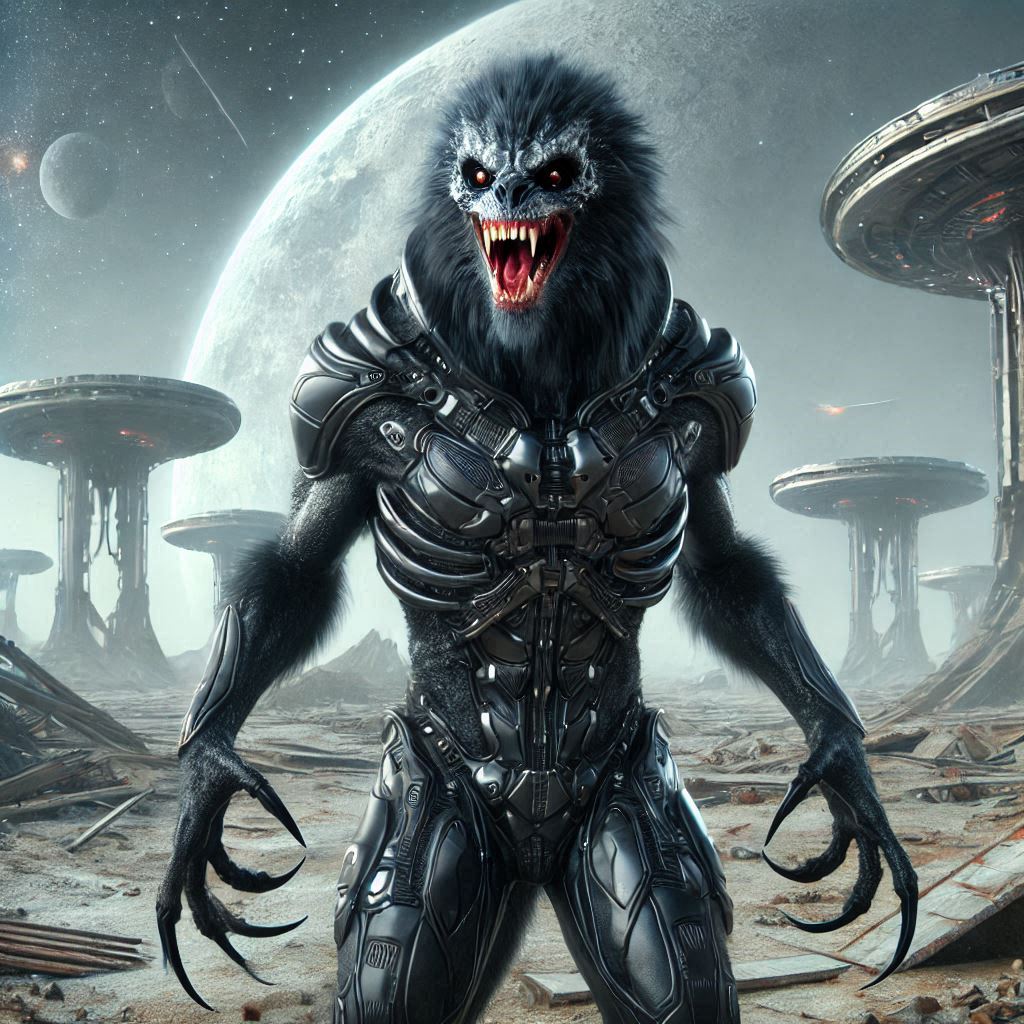The Koryth
Koryth: Harbingers of the Void
An Enigma of Predation
The Koryth are a species shrouded in mystery, their history pieced together through fragmented observations and harrowing encounters. Unlike most sentient races, they have shared nothing of their culture, origin, or aspirations with the galaxy. What is known has been learned through bloodshed and the ruins they leave in their wake.
Origins
While their exact homeworld remains unknown, genetic analysis suggests the Koryth evolved in an environment of relentless competition, likely on a planet where survival demanded unparalleled adaptability and aggression. Their physiology—resilient, lethal, and efficient—supports this theory. Some scientists theorize that their ecosystem favored predation to such an extreme that only apex predators like the Koryth endured.
War Machines by Design
Every aspect of Koryth society revolves around war. Their starships resemble vast, chitinous beasts, designed for breaching and direct assault rather than prolonged engagements. Battle strategies focus on overwhelming their enemies through ferocity and numbers, prioritizing speed and brutality over defensive measures. Their fleets are like locust swarms, stripping entire systems of resources before moving on.
The Koryth Ethos
Koryth behavior indicates a singular driving purpose: domination. Whether this stems from a survivalist creed or an evolutionary imperative remains unclear. What is certain is their disdain for cooperation, even among themselves. Hierarchies are enforced through strength alone, with no place for weakness or dissent.
Contact with Other Species
To other species, the Koryth are a nightmare incarnate. Diplomatic overtures have always been met with violence, and attempts to infiltrate their society have ended in failure or gruesome deaths. Captive Koryth show no inclination to communicate, preferring starvation or suicide to cooperation.
The Terran Conflict
The Koryth's encounter with the Terrans marked one of the few instances where their campaigns met significant resistance. Terran boarding tactics and mechanized warfare have proven effective against the Koryth’s brute-force approach, leading to devastating battles on both sides. Yet, even in defeat, the Koryth adapt and learn, their resilience making them a perpetual threat.
Galactic Perception
The galaxy views the Koryth with a mix of dread and fascination. They are seen as a force of nature—unstoppable, insatiable, and utterly alien. Yet, their apparent lack of long-term strategy or cohesive vision raises questions about their ultimate goals. Are they driven by an ancient purpose, or are they merely the byproduct of a universe that rewards aggression?
For now, the Koryth remain an enigma—a species whose actions speak louder than any words ever could. Their existence is a grim reminder of the galaxy’s darker truths: that survival is not guaranteed, and peace is never permanent.
Basic Information
Anatomy
The Koryth are built for war. Their physiology is a perfect balance of brute strength, agility, and resilience.
- Height: 2.1–2.4 meters
- Weight: 120–180 kilograms
- Skin: Black and leathery, with patches of coarse fur that may serve as a rudimentary sensory system.
- Claws and Teeth: Razor-sharp claws on their hands and feet, paired with serrated teeth designed for tearing flesh.
- Skeleton: Dense, reinforced bone structure capable of withstanding immense force.
Genetics and Reproduction
Koryth procreation is a stark reflection of their ruthless nature. Females lay clutches of 20–30 eggs in communal hatcheries. Upon hatching, the young are abandoned, forced into a brutal fight for survival where only the strongest endure. This natural culling ensures that only the most capable individuals reach maturity.
Growth Rate & Stages
Koryth are long-lived predators with rapid reproductive cycles:
- Eggs (0–6 Months): Laid in clutches of 15–30, hatching within six months.
- Juveniles (6 Months–10 Years): Rapid physical growth, reaching combat readiness by age 5.
- Young Adults (10–100 Years): Peak strength and breeding age, producing multiple clutches during this period.
- Mature Adults (100–600 Years): Retain physical prowess but prioritize leadership and training younger generations.
- Elders (600–900 Years): Rare survivors serve as strategists or revered warlords, their battle-hardened wisdom guiding their kind.do become leaders or advisors, their experience and cunning compensating for diminishing physical prowess.
Ecology and Habitats
Koryth thrive in hostile environments, such as volcanic plains, irradiated wastelands, or derelict space stations. They mold conquered territories into resource pits or spawning grounds, showing no regard for ecological balance.
Dietary Needs and Habits
Hypercarnivores, they favor protein-rich prey, including livestock, sentients, or even other Koryth. Hunting methods are brutal and efficient, ensuring dominance over their ecosystems. They hoard resources to sustain their relentless war campaigns.
Biological Cycle
Active and predatory throughout their lives, Koryth biology is unaffected by seasonal changes. In resource-scarce times, their metabolism slows to prolong survival, and they may resort to cannibalism.
Behaviour
Koryth society is steeped in dominance and survival. They form loose hierarchies based on strength, with infighting commonplace. Mercy is foreign; they respect only power, crushing weaker species without remorse.
Additional Information
Perception and Sensory Capabilities
- Sight: Exceptional night vision, with eyes attuned to low-light environments.
- Olfaction: Acute sense of smell, capable of detecting prey or adversaries from great distances.
- Extrasensory Abilities: Minimal. The Koryth rely on physical prowess rather than subtle senses.




Comments